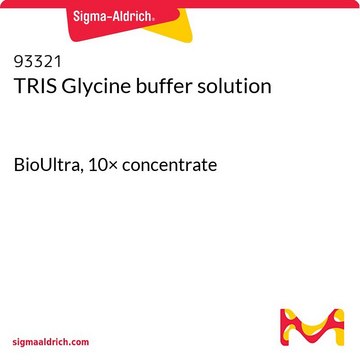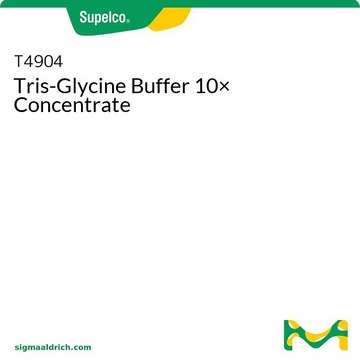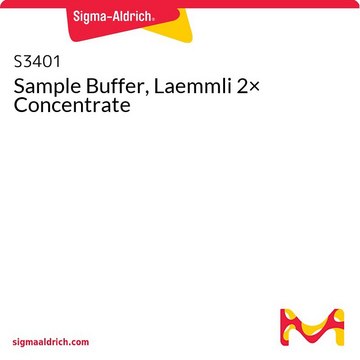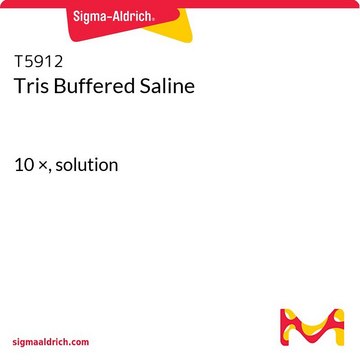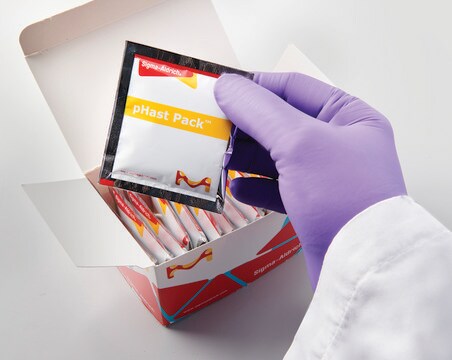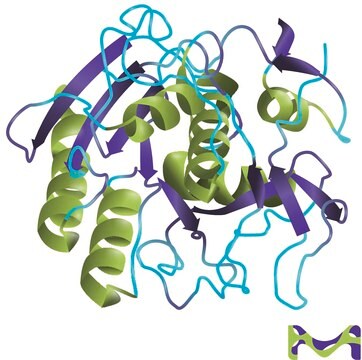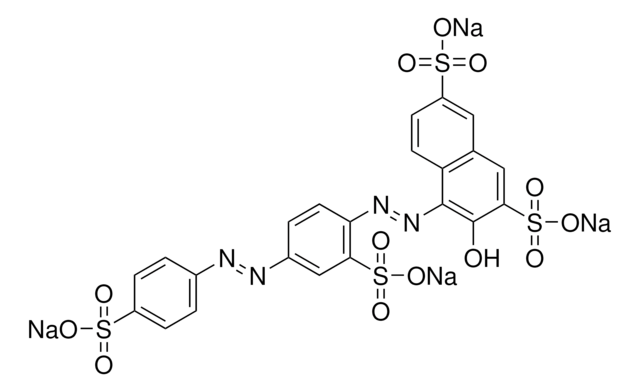T7777
Tris-Glycin-SDS Puffer als 10× Konzentrat
Synonym(e):
TRIS–glycin–SDS-Puffer -Lösung
Anmeldenzur Ansicht organisationsspezifischer und vertraglich vereinbarter Preise
Alle Fotos(1)
About This Item
UNSPSC-Code:
41105319
eCl@ss:
32129211
NACRES:
NA.25
Empfohlene Produkte
Sterilität
0.2 μm filtered
Qualitätsniveau
Form
liquid
Anwendung(en)
diagnostic assay manufacturing
Lagertemp.
2-8°C
Suchen Sie nach ähnlichen Produkten? Aufrufen Leitfaden zum Produktvergleich
Allgemeine Beschreibung
Tris-glycine-SDS (TGS) running buffer is the most commonly used buffer for sodium dodecyl sulfate-polyacrylamide gel electrophoresis (SDS-PAGE) of proteins. TGS is usually used for both anode and cathode buffer. Recommended running conditions is 150 volts for mini vertical gel electrophoresis units.
Anwendung
Tris-glycine-SDS buffer 10× concentrate has been used as a running buffer in sodium dodecyl sulfate-polyacryamide gel electrophoresis (SDS-PAGE). It is also used to block membranes with 5% non-fat dry milk for western blotting. TGS is usually used for both the anode buffer and the cathode buffer. Recommended running conditions is 150 volts for mini vertical gel electrophoresis units.
Rekonstituierung
Dilution of the 10× TGS buffer produces a 1× running buffer containing 25 mM Tris, 192 mM glycine and 0.1% SDS, pH approx. 8.6.
Lagerklassenschlüssel
10 - Combustible liquids
WGK
WGK 1
Flammpunkt (°F)
Not applicable
Flammpunkt (°C)
Not applicable
Persönliche Schutzausrüstung
Eyeshields, Gloves, type ABEK (EN14387) respirator filter
Hier finden Sie alle aktuellen Versionen:
Besitzen Sie dieses Produkt bereits?
In der Dokumentenbibliothek finden Sie die Dokumentation zu den Produkten, die Sie kürzlich erworben haben.
Antitumor Activity and Mechanism of a Reverse Transcriptase Inhibitor, Dapivirine, in Glioblastoma
Liu W, et al.
Journal of Cancer, 117?128-117?128 (2018)
Multiple tandem epitope tagging for enhanced detection of protein expressed in mammalian cells
Zhang L, et al.
Molecular Biotechnology, 19(3), 313-321 (2001)
A Radioisotope-free Oligosaccharyltransferase Assay Method
Yamasaki T and Kohda D
Glycobiology (2007)
Man-Lan Guo et al.
Cell biochemistry and function, 37(2), 72-83 (2019-02-19)
Cancer cell progression and proliferation increase cell density, resulting in changes to the tumour site, including the microenvironment. What is not known is if increased cell density influences the aggressiveness of cancer cells, especially their proliferation, migration, and invasion capabilities.
Weiwen Liu et al.
The Journal of dermatology, 48(3), 289-300 (2020-12-02)
Androgenetic alopecia is the most common form of hair loss disorder. The features of this process are shortening of the anagen phase in hair cycling and progressive miniaturization of the hair follicle. However, the mechanisms in androgenetic alopecia are still
Unser Team von Wissenschaftlern verfügt über Erfahrung in allen Forschungsbereichen einschließlich Life Science, Materialwissenschaften, chemischer Synthese, Chromatographie, Analytik und vielen mehr..
Setzen Sie sich mit dem technischen Dienst in Verbindung.